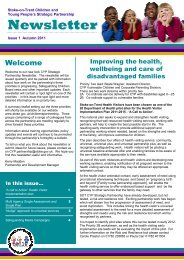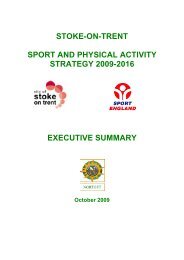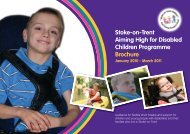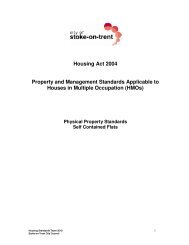Director of Public Health Annual Report 2012 [pdf] - Stoke-on-Trent ...
Director of Public Health Annual Report 2012 [pdf] - Stoke-on-Trent ...
Director of Public Health Annual Report 2012 [pdf] - Stoke-on-Trent ...
Create successful ePaper yourself
Turn your PDF publications into a flip-book with our unique Google optimized e-Paper software.
The percentage <str<strong>on</strong>g>of</str<strong>on</strong>g> women smoking during pregnancy in NHS <str<strong>on</strong>g>Stoke</str<strong>on</strong>g>-<strong>on</strong>-<strong>Trent</strong> in 2011/<str<strong>on</strong>g>2012</str<strong>on</strong>g><br />
was 20.9% (compared with 13.2% in England). This means that <str<strong>on</strong>g>of</str<strong>on</strong>g> the 3,810 local women<br />
who were pregnant (in 2011/<str<strong>on</strong>g>2012</str<strong>on</strong>g>), 797 smoked during pregnancy. Whilst the number <str<strong>on</strong>g>of</str<strong>on</strong>g><br />
women smoking in pregnancy is high, there has been a fall in the percentage <str<strong>on</strong>g>of</str<strong>on</strong>g> women<br />
smoking during pregnancy in NHS <str<strong>on</strong>g>Stoke</str<strong>on</strong>g>-<strong>on</strong>-<strong>Trent</strong> from 23.1% in 2008/2009 to its present<br />
level, which has seen a reducti<strong>on</strong> in the gap between NHS <str<strong>on</strong>g>Stoke</str<strong>on</strong>g>-<strong>on</strong>-<strong>Trent</strong> and England.<br />
However, our c<strong>on</strong>clusi<strong>on</strong> is that there is no clear trend in the gap.<br />
During 2011/12, 64 women who smoked during pregnancy accessed the NHS <str<strong>on</strong>g>Stoke</str<strong>on</strong>g>-<strong>on</strong>-<br />
<strong>Trent</strong> Stop Smoking Service and quit smoking at four weeks. Despite better engagement<br />
with midwives and a change in the way services are commissi<strong>on</strong>ed and delivered there has<br />
been little change in the number <str<strong>on</strong>g>of</str<strong>on</strong>g> pregnant women quitting smoking at four weeks through<br />
the Service over the last six years. It is recognised that the wider c<strong>on</strong>text needs to be<br />
c<strong>on</strong>sidered if smoking in pregnancy is to be tackled successfully. Therefore, the following<br />
acti<strong>on</strong>s will be key priorities for next year:<br />
review the care pathway starting with pre-natal support, right through to postnatal<br />
and bey<strong>on</strong>d<br />
increasing referrals from fr<strong>on</strong>t line staff into the Service, which is improving since the<br />
introducti<strong>on</strong> <str<strong>on</strong>g>of</str<strong>on</strong>g> an ‘opt out’ scheme<br />
gathering insight from key stakeholders, clients and the general public to inform<br />
future development <str<strong>on</strong>g>of</str<strong>on</strong>g> stop smoking services<br />
a review <str<strong>on</strong>g>of</str<strong>on</strong>g> the way stop smoking services are commissi<strong>on</strong>ed<br />
expanding the smoke-free homes project which, although in pilot stage, has<br />
promising early findings<br />
Breastfeeding<br />
Breastfeeding provides the very best and most appropriate nutriti<strong>on</strong> for babies, and has<br />
been shown to have a range <str<strong>on</strong>g>of</str<strong>on</strong>g> health and social benefits. These include helping to protect<br />
babies against infecti<strong>on</strong>, gastroenteritis, urinary tract infecti<strong>on</strong>s, allergies and obesity. Not<br />
<strong>on</strong>ly is breastfeeding more c<strong>on</strong>venient than bottle feeding, but it is also free, resulting in<br />
large financial savings for families. Similarly, as<br />
breastfed babies are less likely to be admitted to<br />
hospital for certain c<strong>on</strong>diti<strong>on</strong>s, there are also large<br />
potential savings for the NHS.<br />
Breastfeeding has been shown to<br />
have a range <str<strong>on</strong>g>of</str<strong>on</strong>g> health and<br />
social benefits<br />
In NHS <str<strong>on</strong>g>Stoke</str<strong>on</strong>g>-<strong>on</strong>-<strong>Trent</strong>, the percentage <str<strong>on</strong>g>of</str<strong>on</strong>g> mothers who started breastfeeding their babies<br />
after birth (in the first 48 hours) was 61.7% in 2011/<str<strong>on</strong>g>2012</str<strong>on</strong>g> (compared with 74.0% in England).<br />
This is the highest percentage <str<strong>on</strong>g>of</str<strong>on</strong>g> babies being breastfed at birth locally since 2004/2005,<br />
when <strong>on</strong>ly 44.0% were breastfed. This increase locally has seen a reducti<strong>on</strong> in the gap<br />
between NHS <str<strong>on</strong>g>Stoke</str<strong>on</strong>g>-<strong>on</strong>-<strong>Trent</strong> and England.<br />
Another indicator which is used to m<strong>on</strong>itor breastfeeding is the percentage <str<strong>on</strong>g>of</str<strong>on</strong>g> babies who are<br />
breastfed at 6 to 8 weeks after birth. In NHS <str<strong>on</strong>g>Stoke</str<strong>on</strong>g>-<strong>on</strong>-<strong>Trent</strong>, 30.6% <str<strong>on</strong>g>of</str<strong>on</strong>g> babies were breastfed<br />
at 6 to 8 weeks in 2011/<str<strong>on</strong>g>2012</str<strong>on</strong>g> (compared with 47.0% in England). Whilst this local figure<br />
remains below that <str<strong>on</strong>g>of</str<strong>on</strong>g> England, the percentage <str<strong>on</strong>g>of</str<strong>on</strong>g> babies breastfed at 6 to 8 weeks in NHS<br />
<str<strong>on</strong>g>Stoke</str<strong>on</strong>g>-<strong>on</strong>-<strong>Trent</strong> has increased from 26.1% in 2008/2009 to its present level.<br />
29 | P a g e


![Director of Public Health Annual Report 2012 [pdf] - Stoke-on-Trent ...](https://img.yumpu.com/32721490/31/500x640/director-of-public-health-annual-report-2012-pdf-stoke-on-trent-.jpg)














